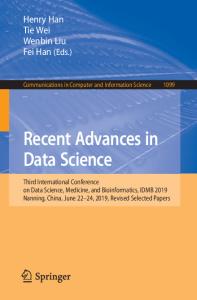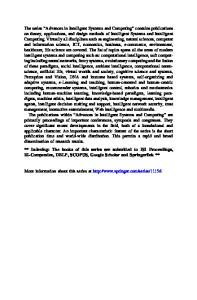Deep learning for non-rigid 3D shape classification based on informative images
- PDF / 3,200,994 Bytes
- 20 Pages / 439.37 x 666.142 pts Page_size
- 95 Downloads / 310 Views
Deep learning for non-rigid 3D shape classification based on informative images Li Han 1 & Jingyu Piao 1 & Yuning Tong 1 & Bing Yu 1 & Pengyan Lan 1 Received: 17 March 2020 / Revised: 30 June 2020 / Accepted: 28 August 2020 # Springer Science+Business Media, LLC, part of Springer Nature 2020
Abstract
In order to enhance the discernment of features in view-based 3D shape recognition, we propose a joint convolutional neural network (CNN) learning model based on informative images. It learns deep features from intrinsic feature images and extrinsic 2D views, and generates a synthetic feature vector via weighted aggregation and refinement process, which has achieved remarkable improvement in non-rigid 3D shape classification. Our joint CNNs model contains three parts: the first part is the geometry-based feature generation unit. We provide a discriminative BoF (bag of features) image descriptor and construct CNN framework to learn the geometric features of the model. The second part is the view-based feature generation unit. We establish a parallel CNN to extract spatial features from optimized 2D views. The third part is a score generation and refinement unit, which automatically learns the weighted scores of geometric features and spatial features. Finally, the aggregated feature is refined in a CNN framework and serves as an informative shape descriptor for recognition task. The experimental results demonstrate that our deep features have the strong discerning ability. Thus, better performance and robustness can be obtained compared to state-of-the-art methods. Keywords Shape classification . Deep learning . Non-rigid 3D shape . View-based 3D shape recognition . Bag-of-features
1 Introduction The advancement in 3D acquisition technique leads to wider applications of 3D models in various fields, triggering a wave of research on shape analysis and classification methods. Especially, the successful application of deep learning technology in visual recognition in recent years has attracted more and more researchers to pay attention to learning-based methods for 3D shape analysis. Among them, view-based learning methods have made
* Li Han [email protected]
1
School of Computer and Information Technology, Liaoning Normal University, Dalian, China
Multimedia Tools and Applications
remarkable achievements in 3D shape classification and retrieval. They make full use of the successful deep learning model in the field of the 2D image, convert 3D shape into a series of 2D images, and then these 2D images are fed into a deep learning framework to extract the view features. The core work of the view-based learning method mainly includes two aspects. One is to generate valuable 2D views, such as projection views, panoramic views, geometry images, etc. [26, 31–33]. The other is to establish an effective learning mechanism to extract discriminative features from images, such as auto-encoder learning, deep belief networks (DBNs) learning, generative adversarial networks (GAN), convolutional neural network (CNN) learning, weighte
Data Loading...











